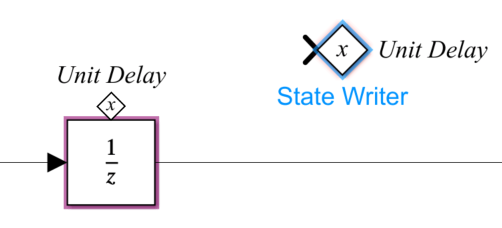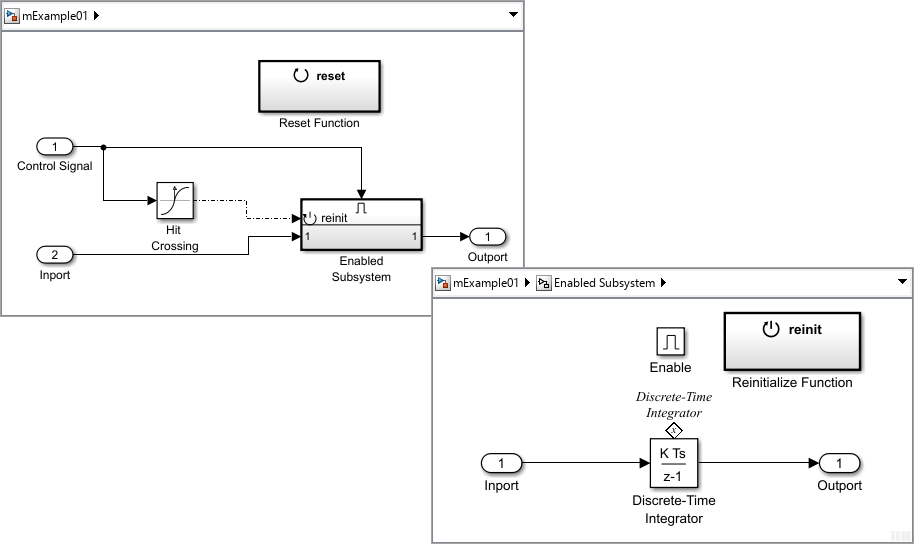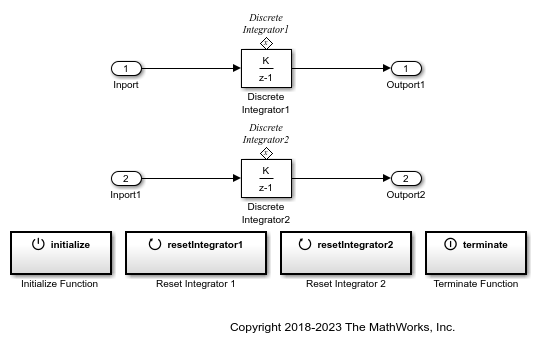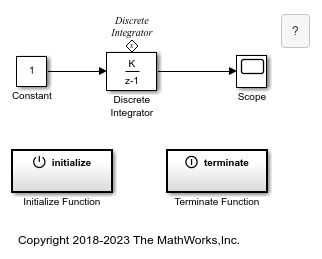State Writer
Write to a block state
Libraries:
Simulink /
Signal Routing
Description
The State Writer block sets the state of a supported state owner block.
State Writer blocks can write state to these state owner blocks:
Discrete State-Space
Discrete-Time Integrator
Delay
Unit Delay
Discrete Transfer Fcn
Discrete Filter
Discrete FIR Filter
Integrator
Second-Order Integrator
Outport of conditional subsystem blocks such as Enabled Subsystem, Triggered Subsystem, and Function-Call Subsystem
S-Function with multiple discrete states
To configure an S-Function block as a state owner block, each data type work vector must be declared as a discrete state vector using
ssSetDWorkUsedAsDStateand named usingssSetDWorkNameorssSetDWorkRTWIdentifierinmdlInitializeSizes.
Tip
You can determine whether a block is a supported state owner block by the value of
the block's IsStateOwnerBlock parameter. The
expression
get_param(blk,'IsStateOwnerBlock')
blk is a block name or handle, returns
'on' if the block is a supported state owner block and
'off' otherwise.To add a State Reader or State Writer block to your
model, click a state owner block to highlight it. Then, from the current block tab of
the Simulink® toolstrip, click Reader-Writer. From the menu, select
State Reader Block or State Writer
Block.
Note
The current block tab of the toolstrip might be labeled with the name of the highlighted block, for example, Outport, or it might be labeled Block, depending on the type of block you highlight.

If the state owner block has multiple states, then the State Reader or State Writer block dialog opens. Select a state from the State Owner Selector Tree.
Note
Before adding a State Reader or State Writer block for a Second-Order Integrator block, you must explicitly name the states. See Specifying the State Names.
After you create a State Reader or State Writer block,
a ![]() badge appears above the state owner block, and the
name of the state owner block appears next to the State Reader or
State Writer block.
badge appears above the state owner block, and the
name of the state owner block appears next to the State Reader or
State Writer block.

A State Reader or State Writer block cannot remain in the same system as its state owner block. After you create a State Reader or State Writer block, cut and paste it to move it to the desired location within the model hierarchy.
Alternatively, you can add a State Reader or State Writer block to your model from the Simulink Library Browser, then set the State owner block parameter from the block parameters dialog.
Note
When you create a library block with a State Reader or State Writer block, you must also include the corresponding state owner block in the library block. In addition to custom library blocks created using the workflow mentioned in Create Custom Library, Simulink treats model components created using Subsystem Reference block as a one-block library.
You can select a State Reader or State Writer block or a
corresponding state owner block to highlight blocks related to it. To show a related
block in an open diagram or new tab, pause on the ellipsis that appears after selection.
Then, select Related Blocks
![]() from the action bar. When multiple blocks correspond
to the selected block, a list of related blocks opens. You can filter the list of
related blocks by entering a search term in the text box. After you select a related
block from the list, window focus goes to the open diagram or new tab that shows the
related block.
from the action bar. When multiple blocks correspond
to the selected block, a list of related blocks opens. You can filter the list of
related blocks by entering a search term in the text box. After you select a related
block from the list, window focus goes to the open diagram or new tab that shows the
related block.
Examples
Limitations
The State Writer block does not support resettable states inside an Enabled Subsystem block. You must use a Reinitialize Function block to implement resettable states inside an Enabled Subsystem block. An external signal received at the enable port of the Enabled Subsystem triggers the execution of the Reinitialize Function block inside the subsystem. For more information on configuring Reinitialize Function block settings, see Reinitialize States of Blocks in Subsystem.

Ports
Input
Parameters
Block Characteristics
Data Types |
|
Direct Feedthrough |
|
Multidimensional Signals |
|
Variable-Size Signals |
|
Zero-Crossing Detection |
|

